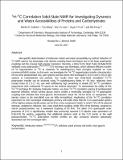| dc.contributor.author | O’Neill, Hugh | |
| dc.contributor.author | Gelenter, Martin David | |
| dc.contributor.author | Wang, Tuo | |
| dc.contributor.author | Liao, Shu-Yu | |
| dc.contributor.author | Hong, Mei | |
| dc.date.accessioned | 2018-07-20T20:09:50Z | |
| dc.date.available | 2018-07-20T20:09:50Z | |
| dc.date.issued | 2017-07 | |
| dc.identifier.issn | 0925-2738 | |
| dc.identifier.issn | 1573-5001 | |
| dc.identifier.uri | http://hdl.handle.net/1721.1/117040 | |
| dc.description.abstract | Site-specific determination of molecular motion and water accessibility by indirect detection of [superscript 2]H NMR spectra has advantages over dipolar-coupling based techniques due to the large quadrupolar couplings and the ensuing high angular resolution. Recently, a Rotor Echo Short Pulse IRrAdiaTION mediated cross polarization (RESPIRATION[subscript CP]) technique was developed, which allowed efficient transfer of [superscript 2]H magnetization to [superscript 13]C at moderate [superscript 2]H radiofrequency field strengths available on most commercial MAS probes. In this work, we investigate the [superscript 2]H–[superscript 13]C magnetization transfer characteristics of one-bond perdeuterated CD[subscript n] spin systems and two-bond H/D exchanged C–(O)–D and C–(N)–D spin systems in carbohydrates and proteins. Our results show that multi-bond, broadband [superscript 2]H–[superscript 13]C polarization transfer can be achieved using 2H radiofrequency fields of ~50 kHz, relatively short contact times of 1.3–1.7 ms, and with sufficiently high sensitivity to enable D [superscript 2]H–[superscript 13]C correlation experiments with undistorted [superscript 2]H spectra in the indirect dimension. To demonstrate the utility of this [superscript 2]H–[superscript 13]C technique for studying molecular motion, we show [superscript 2]H–[superscript 13]C correlation spectra of perdeuterated bacterial cellulose, whose surface glucan chains exhibit a motionally averaged C6 2H quadrupolar coupling that indicates fast trans-gauche isomerization about the C5–C6 bond. In comparison, the interior chains in the microfibril core are fully immobilized. Application of the [superscript 2]H–[superscript 13]C correlation experiment to H/D exchanged Arabidopsis primary cell walls show that the O–D quadrupolar spectra of the highest polysaccharide peaks can be fit to a two-component model, in which 74% of the spectral intensity, assigned to cellulose, has a near-rigid-limit coupling, while 26% of the intensity, assigned to matrix polysaccharides, has a weakened coupling of 50 kHz. The latter O–D quadrupolar order parameter of 0.22 is significantly smaller than previously reported C–D dipolar order parameters of 0.46–0.55 for pectins, suggesting that additional motions exist at the C–O bonds in the wall polysaccharides. [superscript 2]H–[superscript 13]C polarization transfer profiles are also compared between statistically deuterated and H/D exchanged GB1. Keywords: Molecular motion, RESPIRATION[subscript CP], Cellulose, Plant primary cell walls, Trans-gauche isomerization | en_US |
| dc.description.sponsorship | National Science Foundation (U.S.) (Grant GM088204) | en_US |
| dc.publisher | Springer Netherlands | en_US |
| dc.relation.isversionof | http://dx.doi.org/10.1007/s10858-017-0124-7 | en_US |
| dc.rights | Creative Commons Attribution-Noncommercial-Share Alike | en_US |
| dc.rights.uri | http://creativecommons.org/licenses/by-nc-sa/4.0/ | en_US |
| dc.source | Springer Netherlands | en_US |
| dc.title | [superscript 2]H–[superscript 13]C correlation solid-state NMR for investigating dynamics and water accessibilities of proteins and carbohydrates | en_US |
| dc.type | Article | en_US |
| dc.identifier.citation | Gelenter, Martin D., et al. “[superscript 2]H–[superscript 13]C Correlation Solid-State NMR for Investigating Dynamics and Water Accessibilities of Proteins and Carbohydrates.” Journal of Biomolecular NMR, vol. 68, no. 4, Aug. 2017, pp. 257–70. | en_US |
| dc.contributor.department | Massachusetts Institute of Technology. Department of Chemistry | en_US |
| dc.contributor.mitauthor | Gelenter, Martin David | |
| dc.contributor.mitauthor | Wang, Tuo | |
| dc.contributor.mitauthor | Liao, Shu-Yu | |
| dc.contributor.mitauthor | Hong, Mei | |
| dc.relation.journal | Journal of Biomolecular NMR | en_US |
| dc.eprint.version | Author's final manuscript | en_US |
| dc.type.uri | http://purl.org/eprint/type/JournalArticle | en_US |
| eprint.status | http://purl.org/eprint/status/PeerReviewed | en_US |
| dc.date.updated | 2017-09-07T05:21:23Z | |
| dc.language.rfc3066 | en | |
| dc.rights.holder | Springer Science+Business Media B.V. | |
| dspace.orderedauthors | Gelenter, Martin D.; Wang, Tuo; Liao, Shu-Yu; O’Neill, Hugh; Hong, Mei | en_US |
| dspace.embargo.terms | N | en |
| dc.identifier.orcid | https://orcid.org/0000-0002-6412-805X | |
| dc.identifier.orcid | https://orcid.org/0000-0002-1801-924X | |
| dc.identifier.orcid | https://orcid.org/0000-0002-0022-2637 | |
| dc.identifier.orcid | https://orcid.org/0000-0001-5255-5858 | |
| mit.license | OPEN_ACCESS_POLICY | en_US |
